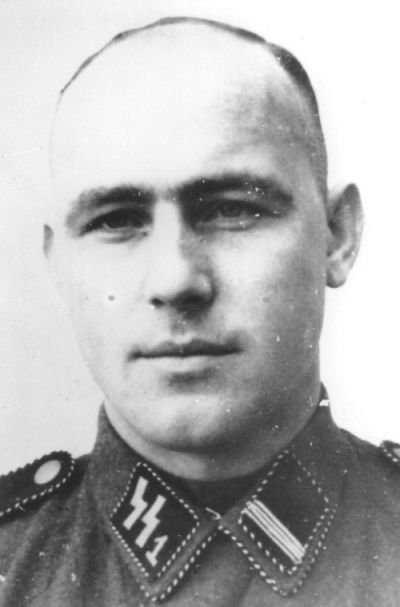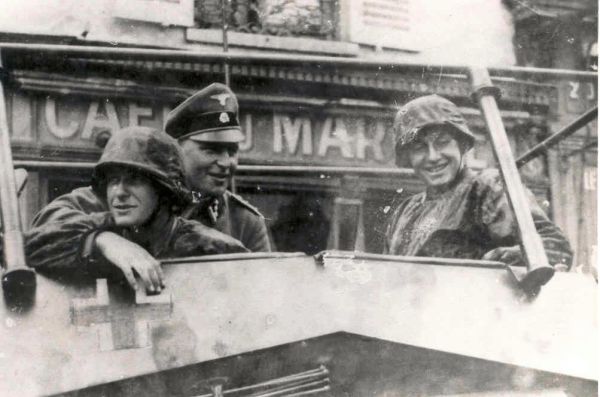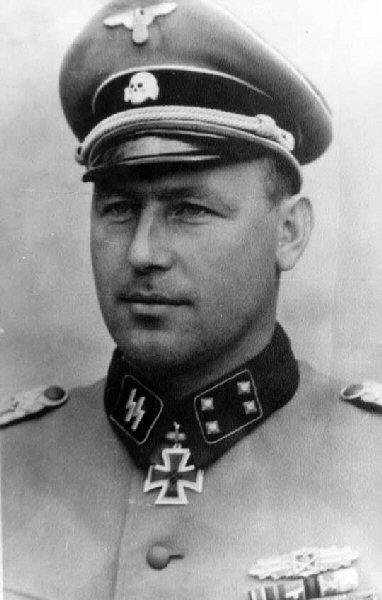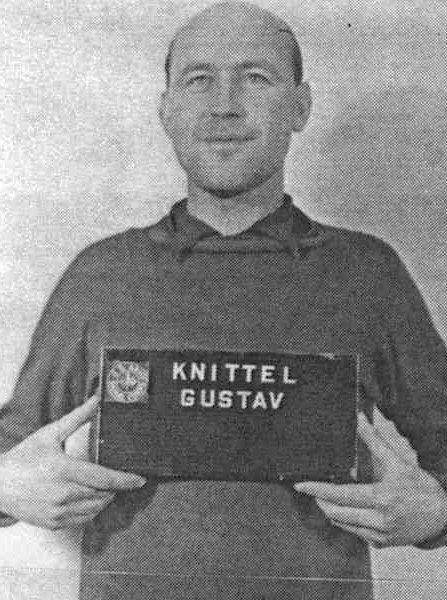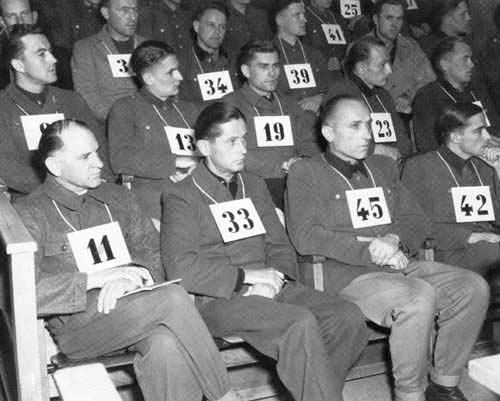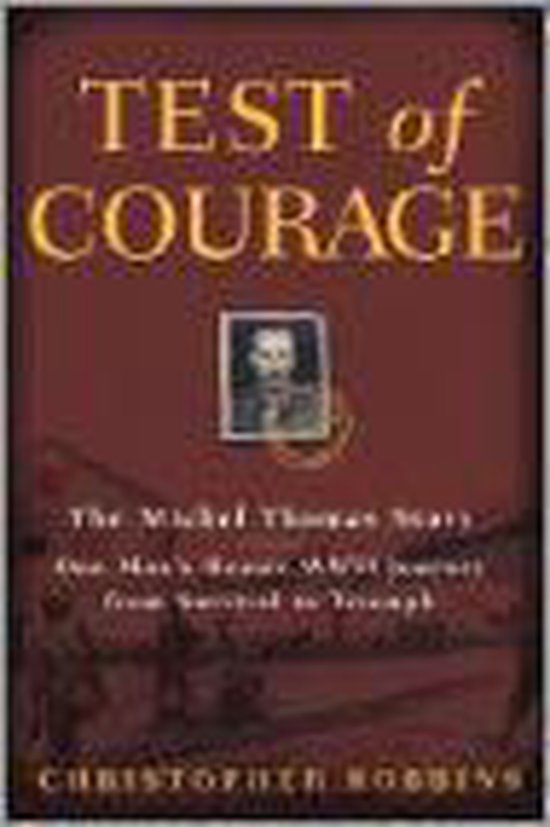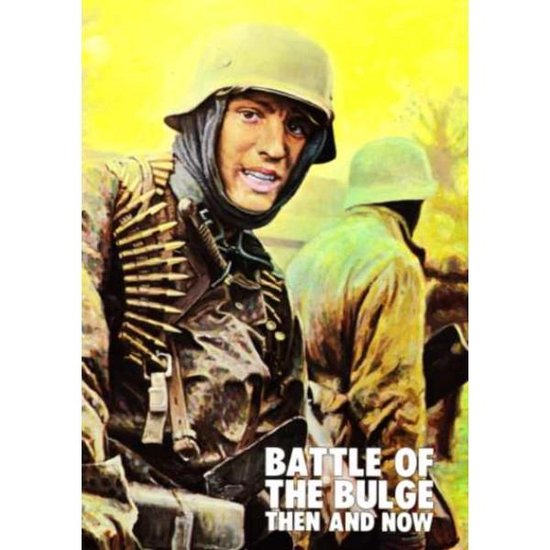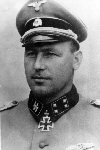Introduction
Gustav Knittel was a convicted war criminal and SS-Sturmbannfüher in the 1. SS-Panzer-Division Leibstandarte-SS Adolf Hitler (LSSHA).Youth
Gustav Knittel was born November 27, 1914 in Neu-Ulm, Bavaria in Germany. He had a twin brother, Bernard and two sisters. His parents, Bernard senior and Theresa Knittel-Pfinder ran a bakery in Neu-Ulm on 52 Schützenstraße. Knittel was educated at the Volksschule (primary school), the Realschule (secondary) in Ulm and at the Oberrealschule (high school) in Göppingen.Early career
On April 15, 1933, Knittel enrolled in the Allgemeine-SS. He assumed this to be a suitable preparation for a professional military career while still at school. As it was a formality for fresh SS members, he became a member of the NSDAP on May 1, 1933. He was posted to the 79. SS-Standarte in Ulm and with this unit, he took part in the Nuremberg party rally of 1933.After having passed his final exams, he applied for a function in the Reichswehr but was rejected. Therefore he decided to start a career in which was later to become the Waffen-SS and in October 1934, he was posted to the SS-Standarte Deutschland of the SS-Verfügungstruppe in Ellwangen. He qualified for the SS-Junkerschule in Bad Tolz in 1938. Knittel returned to his SS-Standarte Deutschland and with this unit he participated in the occupation of the Rhineland after the Treaty of Munich had become effective. He served in various SS units before becoming adjutant of the SS-Ersatz Battalion Ellwangen.
War time career
Shortly before the German invasion of France and the Low Countries, Knittel was transferred to the Leibstandarte as platoon commander in 15. Kompanie. He was to replace Max Wünsche as platoon commander but this was postponed until after the capitulation of the Netherlands. Knittel participated in the battle or France and following the battles of Wormhout and Bollezeele he was awarded the Eisernes Kreuz II; on June 19, 1940 he was injured in Saint-Pourçain-sur-Sioule and transferred to a field hospital in Troyes. During the French campaign, he was also awarded the Infanterie Sturmabzeichen and the Verwundetenabzeichen in Schwarz. When at the end of 1940, 1. SS-Aufklärungsabteilung of the LSSHA in Metz was established by Kurt - Panzer - Meyer, he appointed Knittel commander of 4. Kompanie. Knittel recuperated from his leg injury in the SS hospital in Hohenlychen and returned to the Leibstandarte in November 1940.After having participated in the German attack on Yugoslavia and Greece the next engagement he took part in was Operation Barbarossa: the German invasion of the Soviet Union. He led his company in the advance of the Leibstandarte on Zhytomyr but was injured in the battle for the hills north of Marchlewsk on July 11, 1941. This time he had been injured by shrapnel and shot through his arm pit. He recuperated again in the hospital at Hohenlychen and was subsequently transferred to the SS training camp in Dachau. He was awarded the Eisernes Kreuz I and returned to his company in November.
Knittel distinguished himself on November 19, 1941 during the battles of Rostov, of Sultan-Sali and later between November 27 and December 1 when he was in charge of an unplanned Kampfgruppe to cover the German retreat from Taganrog against the Red Army.
In March 1942 he was appointed commander of 3. Kompanie of the 1. SS-Aufklärungsabteilung LSSHA. He led this company during the battle of Charkov and distinguished himself between February 2 and 4, 1943. He had been put in charge of an unplanned Kampfgruppe, made up from his own company, to cover the retreat of the 298. Infanterie-Division behind enemy lines. In Shevchenkove he made contact with this depleted division, was cut off by the advancing Red Army but managed to make a fighting return to German lines with this group and a number of rescued soldiers. He subsequently distinguished himself again when the 1. SS-Aufklärungsabteilung was surrounded in Alexejewka where he led one of the counter attacks on the Red Army on February 13. The next day, the battalion was saved from destruction when Max Wünsche and his tank regiment managed to reach Alexejewka from Yefremivka. On February 15, Meyer and Wünsche wanted to reach the lines of Fritz Witt and Knittel and his company were dispatched to Bereka in order to reconnoiter the escape route. He found Bereka occupied by the Red Army and got injured in the ensuing attack. Next day, the combined forces of Meyer and Wünsche managed to reach Yefremivka. Knittel was treated for his leg injury and returned to his company for the counter attack on Charkov.
In April 1943, Meyer left the battalion and Knittel succeeded him. He got injured on July 11 during the battle for Kursk but he stayed with his troops. Knittel led his battalion in Italy and distinguished himself during the during the winter battles of 1943 to 1944 in the Ukraine near Turbovka and near Divin where he personally led his men past the defensive positions of the Red Army and captured the city in a surprise attack from the east. On January 23, 1944, he was awarded the Deutsches Kreuz in Gold.
He continued to command the remnants of his battered battalion during the fighting in February and March, earning the Ritterkreuz des Eisernen Kreuzes for having secured the Bowenez pocket between Tenopil and Proskurov on March 13 and for his defense of Hill 300 south of Andrejewka between March 30 and April 1, 1944. In order to defend this hill, Knittel led the men of the 68. Infanterie-Division back to their defensive positions after they had been chased out by the Red Army. Next he managed to repel four attacks by the Red Army that day and yet another one on April 1. This enabled the German army to cross the river Zbruch safely and retreat towards Lemberg. The decimated Leibstandarte was subsequently transferred to Belgium. Knittel set up his headquarters in Tournai where he was awarded the Ritterkreuz on June 4, 1944.
A week after D-Day, the Leibstandarte was transferred to Normandy and Knittel subsequently led his battalion during the German efforts to hold back the Allied invasion. It was in Normandy that he realized Germany was going to lose the war, in particular because he had witnessed the destructive power of the Allied fighter bombers and artillery during Operation Lüttich and in the Falaise pocket. After the retreat from France, Knittel left for Neu-Ulm for a short holiday. He was awarded the Nahkampfspange in Gold on October 13, 1944 and did all he could to get a position behind the front. He found it as commander of the Feld-Ersatz-Battalion LSSHA in Lübbecke.
Battle of the Ardennes
Wilhelm Mohnke ordered Knittel to return to the Leibstandarte. On December 13, 1944 he arrived at divisional headquarters near Euskirchen where he asked Mohnke to put Emil Wawrzinek in command of the 1. SS-Aufklärungsabteilung LSSHA. Since its return from France, Wawrzinek had commanded the battalion and had re-established it during the past months. But next day, Mohnke insisted Knittel should command the reinforced battalion: it would become Schnelle Gruppe Knittel.The same day, December 14, Knittel was briefed about the imminent operation Wache am Rhein, the German attempt to breach the Allied lines in the Ardennes and drive a wedge between the Allied forces. Using the Leibstandarte as spear point of Joseph Dietrich's 6. Panzer Armee, Schnelle Gruppe Knittel was to follow the Kampfgruppen of Joachim Peiper and Max Hansen in their tracks and subsequently make use of its speed to capture a bridge across the river Meuse south of Liège, enabling the Leibstandarte to advance on Antwerp. On December 15, Knittel was informed further at the headquarters of Hermann Priess, commanding officer of 1. SS-Panzerkorps. During this briefing, Otto Skorzény was introduced and the details of Operation Greif were unveiled. After this meeting, Knittel drove back to the command post of his battalion in Glaadt to pass on the orders and detailed information on to his company commanders.
The offensive was launched the next day, December 16, 1944. Initially, Knittel advanced quickly through Holzheim, Hosingen, Honsfeld and Born on the heels of Peiper and Hansen without contacting the enemy. On December 17, a reconnaissance group of Schnelle Gruppe Knittel murdered 11 Afro-American soldiers of the 333rd Artillery Battalion in Wéreth.
On December 18, it became obvious that Peiper was making the fastest progress and Knittel was ordered by Mohnke to follow this Kampfgruppe. After a short meeting with Hansen in Recht, Knittel advanced on Stavelot. After having left instructions for his company commanders, Knittel crossed the bridge across the Amblève at Stavelot around noon to establish contact with Peiper In La Gleize. Parts of his unit followed during the afternoon and early evening but the American 30th Infantry Division succeeded in recapturing the northern part of the city, blocking the routes of advance of both Schnelle Gruppe Knittel and Kampfgruppe Rudolf Sandig. Next day, December 19, Mohnke ordered Knittel and the elements of his unit that had managed to reach La Gleize to return to Stavelot to recapture the city and open the route of advance that was essential for supplying Kampfgruppe Peiper with fuel and ammunition. Knittel set up his command post in la Ferme Antoine, a farm west of Stavelot. His counter attack failed but that day, members of his battalion murdered citizens in Parfondruy, Renardmont and Stavelot. That night, the Americans blew the bridge at Stavelot.
Increasing pressure by American troops halted the advance of the Leibstandarte and repeated efforts by Knittel and Sandig to recapture Stavelot failed whilst Peiper was stopped in his tracks at La Gleize. Elements of Schnelle Gruppe Knittel on the west bank of the Amblève were locked in between Stavelot, Coo and Trois-Ponts. On December 20, Task Force Lovelady of the 3rd Armored Division attacked Knittel's positions from the direction of Trois-Ponts but the attack was stopped by a Königstiger tank and a number of anti-tank guns deployed near Petit-Spai. That evening, elements of the 82nd Airborne Division took up positions near Petit-Spai and closed the road to Wanne. On December 21, units of the 3rd Armored Division forced the Schnelle Gruppe Knittel out of its positions in Ster. Elements of Kampfgruppe Hansen had reached Petit-Spai during the night and its counter attack drove the 82nd Airborne Division back to Trois-Ponts. On December 22, a massive attack by the 30th Infantry Division drove Knittel's men from their positions west of Stavelot.
It had become clear the Meuse could not be reached and on December 24 Peiper decided to abandon his vehicles and evade capture by escaping through the woods on foot. He left La Gleize with the remainder of his men. He reached the German lines at Petit-Spai 36 hours later and retreated towards Wanne. In the early morning of December 25, Knittel evacuated his positions on the west bank of the Amblève and he also retreated to Wanne. There the Leibstandarte was reorganized before moving to the vicinity of Bastogne. The Ardennes offensive ended for Knittel on December 31, 1944 when his command post close to Vielsalm was bombed by aircraft of the American 9th Tactical Air Force. He sustained a severe concussion and was admitted to a hospital in Germany.
Trial
In May 1945, Knittel returned to his family in Neu-Ulm but he soon decided to go into hiding in a farm near Stuttgart. He returned to his home town later that year but when he tried to meet his wife on January 5, 1946, he was arrested by Michael Thomas and Theodore Kraus, agents of the US Counter Intelligence Corps. Knittel was detained in the CIC prison in Ulm where he was interrogated by Thomas. Knittel later argued he had been physically maltreated by his guards but Thomas denied this accusation.In March, Knittel was transferred to Schwäbische Hall where Peiper and other suspects of the Malmédy blood bath were being held prisoner. Knittel and his Schnelle Gruppe had not taken part in this blood bath as he had followed a more southerly route but Knittel was soon interrogated about war crimes in Stavelot and surroundings. Knittel confessed he had given orders to murder American prisoners-of-war near Petit-Spai. Just like other defendants he complained after his trial that the interrogations had been accompanied by mental torture. Knittel claimed he had been threatened to be handed over to the Belgians and that his interrogators suggested that signing a confession meant choosing between a fair American trial and Belgian revenge. Knittel also hoped a false confession would draw the attention of his interrogators away from the citizens the men under his command had murdered in Stavelot, Parfondruy and Renardmont and that he could prove during his trial that the murders he had confessed to had never even taken place. He had intended to use the war diaries of American units his Schnelle Gruppe had been fighting against during the Ardennes offensive, to show that on that day and location he had mentioned in his confession, no Americans had been murdered. During the trial however, his defense received no permission to use these diaries and as a result of his self incriminating confession, he was sentence to life on July 16, 1946.
Knittel and his lawyers immediately appealed to the War Crimes Board of Review to have his case re-opened and in March 1948, his penalty was reduced to 15 years. In May 1948, the War Crimes Review Board Nr. 4 rejected the complaint that irregularities had occurred during Knittel's trial but on occasion of the Simpson Report and the findings of the United States Senate Committee on Armed Services, his penalty was further reduced to 12 years. Knittel was released from Landsberg prison on December 7, 1953 on occasion of a Christmas amnesty.
Epilogue
Knittel worked as a car salesman for Opel in Ulm until health problems, including a number of cardiac arrests forced him into retirement in 1970. Gustav Knittel passed away on June 30, 1976, in a hospital in Ulm.Definitielijst
- Ardennes offensive
- Battle of the Bulge, “Von Rundstedt offensive“ or “die Wacht am Rhein“. Final large German offensive in the west from December 1944 through January 1945.
- capitulation
- Agreement between fighting parties concerning the surrender of a country or an army.
- D-Day
- The day of the long awaited invasion of western Europe in Normandy, France, 6 June 1944. After a long campaign of deception the allies attacked the coast of Normandy on five beaches to begin their march on Nazi Germany. Often explained as Decision Day, though this is entirely correct. The D stands for Day as generally used in military language. In this case it means an operation beginning on day D at hour H. Hence “Jour J“ in French.
- Eisernes Kreuz
- Iron Cross. German military decoration.
- Infantry
- Foot soldiers of a given army.
- invasion
- Armed incursion.
- Kampfgruppe
- Temporary military formation in the German army, composed of various units such as armoured division, infantry, artillery, anti-tank units and sometimes engineers, with a special assignment on the battlefield. These Kampfgruppen were usually named after the commander.
- Leibstandarte
- Elite troops, originally Hitler’s body guards. Starting as a motorized infantry regiment it grew into a Panzer division.
- offensive
- Attack on a smaller or larger scale.
- Red Army
- Army of the Soviet Union.
- regiment
- Part of a division. A division divided into a number of regiments. In the army traditionally the name of the major organised unit of one type of weapon.
- Reichswehr
- German army during the Weimar republic.
- Rhineland
- German-speaking demilitarized area on the right bank of the Rhine which was occupied by Adolf Hitler in 1936 after World War 1.
- Soviet Union
- Soviet Russia, alternative name for the USSR.
- Waffen-SS
- Name of Military section of the SS.
- war crimes
- Crimes committed in wartime. Often concerning crimes committed by soldiers against civilians.
Images
Information
- Translated by:
- Arnold Palthe
- Published on:
- 19-01-2025
- Feedback?
- Send it!
Related books
Sources
- LEHMANN, R. & TIEMANN, R., The Leibstandarte vol. III, Fedorowicz Publishing, Inc..
- LEHMANN, R. & TIEMANN, R., The Leibstandarte vol. IV/1, Fedorowicz Publishing, Inc..
- MEYER, K., Grenadiers: The Story Of Waffen SS General Kurt 'Panzer' Meyer, Stackpole Military History, 2005.
- PALLUD, J.P. & RAMSEY, W.G., Battle Of The Bulge.
- ROBBINS, C., Test of Courage: The Michel Thomas Story, New York Free Press/Simon & Schuster, 2000.
- SS Personalakten - Record Group 242, Publication A3343, SSO, Roll 185 (NARA).
- SS RuSHA Akten - Record Group 242, Publication A3343, Series RS, Roll C5567 (NARA).
- Kriegstagebuch LAH RS/1215 (Bundesarchiv-Militärarchiv).
- Verlustmeldungen der Aufklärungsabteilung LAH, Microfilm M861 (Bundesarchiv-Militärarchiv).
- Vorschlag zum Deutschen Kreuz in Gold - Moore, John P. Führerliste der Waffen-SS (2003). J.P. Moore Publishing.
- Vorschlag zum Ritterkreuz - Moore, John P. Führerliste der Waffen-SS (2003). J.P. Moore Publishing.
- Aussagen Gustav Knittels im Malmedy-Prozeß, Microfilm P26-A (NARA).
- Kartheuser, Bruno. Dokumentation Kriegsverbrechen Stavelot Dezember 1944 – Documentation Crimes de guerre Stavelot, décembre 1944 (1994). Krautgarten, St. Vith.
- Letter from Gustav Knittel to the head of the U.S. Army Secret Service, dated 5 January 1950 (NARA).
- Aussagen Gustav Knittels im Malmedy-Prozeß, Microfilm P82-A (NARA).
- Affidavit by Gustav Knittel, dated 15 March 1948 (NARA).
- Affidavit by Gustav Knittel, dated 1 May 1949 (NARA).
- Letter from Gustav Knittel to Willis M. Everett jr., dated 16 February 1948 (NARA).
- TracesOfWar.com
